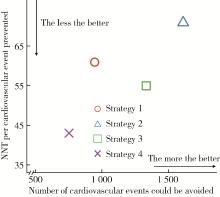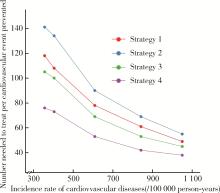Journal of Peking University (Health Sciences) ›› 2024, Vol. 56 ›› Issue (3): 441-447. doi: 10.19723/j.issn.1671-167X.2024.03.010
Previous Articles Next Articles
Comparison of initiation of antihypertensive therapy strategies for primary prevention of cardiovascular diseases in Chinese population: A decision-analytic Markov modelling study
Tianjing ZHOU1,Qiuping LIU1,Minglu ZHANG1,Xiaofei LIU1,Jiali KANG1,Peng SHEN2,Hongbo LIN2,Xun TANG1,3,*( ),Pei GAO1,3,4,*(
),Pei GAO1,3,4,*( )
)
- 1. Department of Epidemiology and Biostatistics, Peking University School of Public Health, Beijing 100191, China
2. Yinzhou District Center for Disease Control and Prevention, Ningbo 315101, Zhejiang, China
3. Key Laboratory of Epidemiology of Major Diseases (Peking University), Ministry of Education, Beijing 100191, China
4. Center for Real-world Evidence Evaluation, Peking University Clinical Research Institute, Beijing 100191, China
CLC Number:
- R54
| 1 |
Mensah GA , Fuster V , Murray CJL , et al. Global burden of cardiovascular diseases and risks, 1990—2022[J]. J Am Coll Cardiol, 2023, 82 (25): 2350- 2473.
doi: 10.1016/j.jacc.2023.11.007 |
| 2 |
胡大一, 韩雅玲, 宁光, 等. 中国心血管病一级预防指南[J]. 中华心血管病杂志, 2020, 48 (12): 1000- 1038.
doi: 10.3760/cma.j.cn112148-20201009-00796 |
| 3 |
Whelton PK , Carey RM , Aronow WS , et al. 2017 ACC/AHA/AAPA/ABC/ACPM/AGS/APhA/ASH/ASPC/NMA/PCNA guideline for the prevention, detection, evaluation, and management of high blood pressure in adults: Executive summary: A report of the American College of Cardiology/American Heart Association task force on clinical practice guidelines[J]. Hypertension, 2018, 71 (6): 1269- 1324.
doi: 10.1161/HYP.0000000000000066 |
| 4 | Boffa RJ , Constanti M , Floyd CN , et al. Hypertension in adults: Summary of updated NICE guidance[J]. BMJ, 2019, 367, l5310. |
| 5 |
Lu Y , Wang P , Zhou T , et al. Comparison of prevalence, awareness, treatment, and control of cardiovascular risk factors in China and the United States[J]. J Am Heart Assoc, 2018, 7 (3): e007462.
doi: 10.1161/JAHA.117.007462 |
| 6 |
Lin H , Tang X , Shen P , et al. Using big data to improve cardiovascular care and outcomes in China: A protocol for the Chinese electronic health records research in Yinzhou (CHERRY) study[J]. BMJ Open, 2018, 8 (2): e019698.
doi: 10.1136/bmjopen-2017-019698 |
| 7 |
WHO CVD Risk Chart Working Group . World Health Organization cardiovascular disease risk charts: Revised models to estimate risk in 21 global regions[J]. Lancet Glob Health, 2019, 7 (10): e1332- e1345.
doi: 10.1016/S2214-109X(19)30318-3 |
| 8 |
Wang JG , Staessen JA , Franklin SS , et al. Systolic and diastolic blood pressure lowering as determinants of cardiovascular outcome[J]. Hypertension, 2005, 45 (5): 907- 913.
doi: 10.1161/01.HYP.0000165020.14745.79 |
| 9 |
Herrett E , Gadd S , Jackson R , et al. Eligibility and subsequent burden of cardiovascular disease of four strategies for blood pressure-lowering treatment: A retrospective cohort study[J]. Lancet, 2019, 394 (10199): 663- 671.
doi: 10.1016/S0140-6736(19)31359-5 |
| 10 | 巩超, 刘秋萍, 王佳敏, 等. 社区人群他汀干预策略预防心血管病效果的马尔可夫模型评价[J]. 北京大学学报(医学版), 2022, 54 (3): 443- 449. |
| 11 |
Blood Pressure Lowering Treatment Trialists' Collaboration . Pharmacological blood pressure lowering for primary and secondary prevention of cardiovascular disease across different levels of blood pressure: An individual participant-level data meta-analysis[J]. Lancet, 2021, 397 (10285): 1625- 1636.
doi: 10.1016/S0140-6736(21)00590-0 |
| 12 |
Wang M , Moran AE , Liu J , et al. Cost-effectiveness of optimal use of acute myocardial infarction treatments and impact on coronary heart disease mortality in China[J]. Circ Cardiovasc Qual Outcomes, 2014, 7 (1): 78- 85.
doi: 10.1161/CIRCOUTCOMES.113.000674 |
| 13 |
The China PEACE Collaborative Group . Association of age and blood pressure among 3.3 million adults: Insights from China PEACE million persons project[J]. J Hypertens, 2021, 39 (6): 1143- 1154.
doi: 10.1097/HJH.0000000000002793 |
| 14 |
Kim S , Chang Y , Kang J , et al. Relationship of the blood pressure categories, as defined by the ACC/AHA 2017 blood pressure guidelines, and the risk of development of cardiovascular disease in low-risk young adults: Insights from a retrospective cohort of young adults[J]. J Am Heart Assoc, 2019, 8 (11): e011946.
doi: 10.1161/JAHA.119.011946 |
| 15 |
Qi Y , Han X , Zhao D , et al. Long-term cardiovascular risk associated with stage 1 hypertension defined by the 2017 ACC/AHA hypertension guideline[J]. J Am Coll Cardiol, 2018, 72 (11): 1201- 1210.
doi: 10.1016/j.jacc.2018.06.056 |
| 16 |
Wang Z , Hao G , Wang X , et al. Clinical outcomes and economic impact of the 2017 ACC/AHA guidelines on hypertension in China[J]. J Clin Hypertens, 2019, 21 (8): 1212- 1220.
doi: 10.1111/jch.13609 |
| 17 |
Chen T , Yu D , Cornelius V , et al. Potential health impact and cost-effectiveness of drug therapy for prehypertension[J]. Int J Cardiol, 2017, 240, 403- 408.
doi: 10.1016/j.ijcard.2017.05.003 |
| 18 | Zhang M , Shi Y , Zhou B , et al. Prevalence, awareness, treatment, and control of hypertension in China, 2004-18: Findings from six rounds of a national survey[J]. BMJ, 2023, 380, e071952. |
| 19 | Li J , Zhao D , Cai J , et al. Cost-effectiveness of treatment in adults with blood pressure of 130-139/80-89 mmHg and high cardiovascular risk in China: A modelling study[J]. Lancet Reg Health West Pac, 2024, 42, 100962. |
| 20 |
Karmali KN , Lloyd-Jones DM , van der Leeuw J , et al. Blood pressure-lowering treatment strategies based on cardiovascular risk versus blood pressure: A meta-analysis of individual participant data[J]. PLoS Med, 2018, 15 (3): e1002538.
doi: 10.1371/journal.pmed.1002538 |
| 21 |
Zhou M , Wang H , Zeng X , et al. Mortality, morbidity, and risk factors in China and its provinces, 1990—2017: A systematic analysis for the global burden of disease study 2017[J]. Lancet, 2019, 394 (10204): 1145- 1158.
doi: 10.1016/S0140-6736(19)30427-1 |
| [1] | Ming-lu ZHANG,Qiu-ping LIU,Chao GONG,Jia-min WANG,Tian-jing ZHOU,Xiao-fei LIU,Peng SHEN,Hong-bo LIN,Xun TANG,Pei GAO. Comparison of aspirin treatment strategies for primary prevention of cardiovascular diseases: A decision-analytic Markov modelling study [J]. Journal of Peking University (Health Sciences), 2023, 55(3): 480-487. |
| [2] | Jia-min WANG,Qiu-ping LIU,Ming-lu ZHANG,Chao GONG,Shu-dan LIU,Wei-ye CHEN,Peng SHEN,Hong-bo LIN,Pei GAO,Xun TANG. Effectiveness of different screening strategies for type 2 diabete on preventing cardiovascular diseases in a community-based Chinese population using a decision-analytic Markov model [J]. Journal of Peking University (Health Sciences), 2022, 54(3): 450-457. |
| [3] | Chao GONG,Qiu-ping LIU,Jia-min WANG,Xiao-fei LIU,Ming-lu ZHANG,Han YANG,Peng SHEN,Hong-bo LIN,Xun TANG,Pei GAO. Effectiveness of statin treatment strategies for primary prevention of cardiovascular diseases in a community-based Chinese population: A decision-analytic Markov model [J]. Journal of Peking University (Health Sciences), 2022, 54(3): 443-449. |
| [4] | LIU Qiu-ping,CHEN Xi-jin,WANG Jia-min,LIU Xiao-fei,SI Ya-qin,LIANG Jing-yuan,SHEN Peng,LIN Hong-bo,TANG Xun,GAO Pei. Effectiveness of different screening strategies for cardiovascular diseases prevention in a community-based Chinese population: A decision-analytic Markov model [J]. Journal of Peking University (Health Sciences), 2021, 53(3): 460-466. |
| [5] | GUO Zi-ning, LIANG Zhi-sheng, ZHOU Yi, ZHANG Na, HUANG Jie. Genetic study of cardiovascular disease subtypes defined by International Classification of Diseases [J]. Journal of Peking University (Health Sciences), 2021, 53(3): 453-459. |
| [6] | Jia-li CHEN,Yue-bo JIN,Yi-fan WANG,Xiao-ying ZHANG,Jing LI,Hai-hong YAO,Jing HE,Chun LI. Clinical characteristics and risk factors of cardiovascular disease in patients with elderly-onset rheumatoid arthritis: A large cross-sectional clinical study [J]. Journal of Peking University (Health Sciences), 2020, 52(6): 1040-1047. |
| [7] | YANG Chao, WANG Jin-wei, YANG Yao-zheng, BAI Kun-hao, GAO Bi-xia, ZHAO Ming-hui, ZHANG Lu-xia, WU Shou-ling, WANG Fang. Impact of anemia and chronic kidney disease on the risk of cardiovascular disease and all-cause mortality among diabetic patients [J]. Journal of Peking University(Health Sciences), 2018, 50(3): 495-500. |
| [8] | SI Ya-qin, TANG Xun, ZHANG Du-dan, HE Liu, CAO Yang, WANG Jin-wei, LI Na, LIU Jian-jiang, GAO Pei, HU Yong-hua. Effectiveness of different screening strategies for primary prevention of cardiovascular diseases in a rural northern Chinese population [J]. Journal of Peking University(Health Sciences), 2018, 50(3): 443-449. |
| [9] | TANG Xun1, ZHANG Du-dan, HE Liu, CAO Yang, WANG Jin-wei, LI Na, HUANG Shao-ping, DOU Hui-dong, GAO Pei, HU Yong-hua. Application of the China-PAR risk prediction model for atherosclerotic cardiovascular disease in a rural northern Chinese population [J]. Journal of Peking University(Health Sciences), 2017, 49(3): 439-445. |
| [10] | GAO Ying, ZHU Cheng-gang, WU Na-qiong, GUO Yuan-lin, LIU Geng, DONG Qian, LI Jian-jun. Study on the reliability of CardioChek PA for measuring lipid profile [J]. Journal of Peking University(Health Sciences), 2016, 48(3): 523-528. |
| [11] | YU Yang, SHENG Qin-Hui, ZHANG Bao-Wei, DING Wen-Hui. Left atrial size predicts adverse cardiac events in patients with non-obstruction hypertrophic cardiomyopathy [J]. Journal of Peking University(Health Sciences), 2014, 46(2): 207-210. |
|
||





